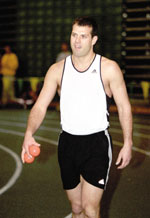Athlete shoots for Olympic spotlight in 2008 Beijing Games

Chris Essick, professional joggler, performed at the Feb. 8 meet.
Running a 200-meter dash in one of 17 heats in 26 seconds at a division two college meet, one can expect around a 64th place finish, but if one tries running the 200 while juggling three balls, one finds himself in the Guinness Book of Records.
Chris Essick is one of several athletes who strives and tries to maintain records in the 200- and 400-meter dashes on the indoor and outdoor track every year.
Joggling is not a new sport. It first appeared in the 1932 Olympic Games in Los Angeles, where many different events, such as joggling, not featured in today’s Olympics, took place. George Roth won the gold medal in the event, and that was the first and last time joggling was an Olympic event.
Essick was born and raised in Ozark where, during his high school career, he was a three-sport athlete in football, wrestling and track and field. He attended Missouri Valley College and ran the decathlon.
During his high school years, a 38-year-old by the name of Albert Lucas, who is classified by the Guinness Book of Records as the world’s greatest joggler, came to Branson for a joggling showdown. He had asked the Branson Chamber of Commerce if there was someone it recommended to train with, and it suggested Essick. Lucas holds the 110 and 410 hurdle records while joggling.
“I didn’t even know how to juggle when I started doing this,” Essick said. “I ran track all my life, never did juggle at all.”
Essick took it upon himself to learn Lucas’ techniques and train to become what he is today.
To teach himself, Essick would stand up with his back against a wall and juggle without moving his arms because if one uses too much power to get the balls in the air, they would go all over the place.
Essick said it also helps to find a happy medium between concentrating on the balls in front of and looking left and right with peripheral vision.
“The running is second nature, you have to keep control of the balls,” Essick said.
Since Essick’s college days, he has broken records in the outdoor 200- and 400-meter dashes while joggling, as well as the indoor 200-meter dash. Jamie Mosley currently owns the indoor 400-meter dash joggling record, which Essick was going to attempt Feb. 9, but didn’t because of a strained hamstring.
He has attempted breaking records at Missouri Southern for the past three years, both outdoor and indoor.
“I always enjoy Chris coming into our meets, he’s always welcome,” said Tom Rutledge, men’s track and field head coach.
“Anybody that can run and juggle as fast as he can is really quite a sight to see.”
Junior track athlete, Jeremiah Still, has been Essick’s pacer every time. They have broken two indoor records and one outdoor together.
“It’s a really unique experience…it’s exciting because you’re in the moment and you’re part of something that is ‘world’ and you feel that and it takes you outside of your bubble,” said Still.
Still has to stay in front, keeping Essick on a pace to beat the record.
“I’ve had good luck with Jeremiah being a good pacer,” Essick said. “He’s a smart kid…I’m very lucky to have a pacer like that, to know the language of track and field and know what I’m trying to accomplish and he’s been a great asset to me.”
Essick entered an application for joggling into the 2008 Olympics, which are set to be held in Beijing, China.
“We felt that they (China) were more willing to take it (joggling) than Greece was,” Essick said.
Essick thinks the Chinese are more susceptible to taking the application as opposed to the Greeks because of their background in the circus field.
“We’re not really trying to get the circus attire on the track, because we want to keep it as professional as possible,” Essick said.
“We’re not just out here being a Mickey Mouse operation; it’s really a tough thing to do. It takes a lot of coordination, hand and eye coordination, it’s not easy.”
Your donation will support the student journalists of Missouri Southern State University. Your contribution will allow us to purchase equipment and cover our annual website hosting costs.



























